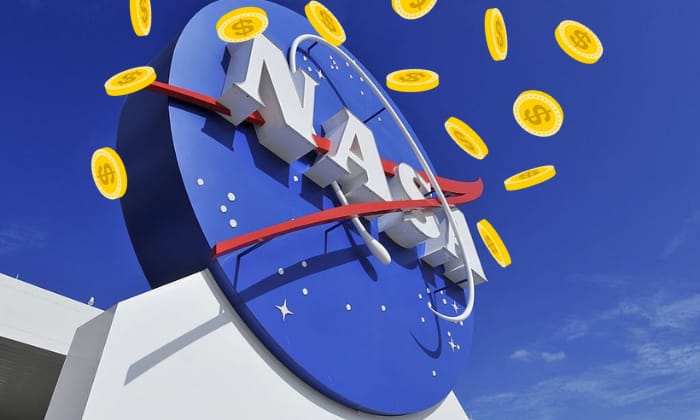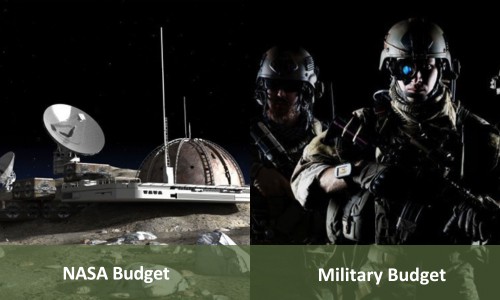Every year, governments all across the world must carefully balance competing priorities when deciding how to allocate scarce resources. NASA, which represents space exploration, and the military, which represents national security, fight for an annual budget in the United States.
Both are critical to the country’s development, yet their goals, operations, and rewards are vastly different.
Today, we will compare the NASA budget vs military budget. We’ll look at the parallels and differences, as well as the benefits and drawbacks of spending money on each. This comparison should shed light on the opposing dynamics at work.
Table of Contents
Overview
The annual federal budget process in the United States is pretty complex, with many people and organizations involved.
A quick rundown of the budget process goes like this: Budget proposals are submitted to Congress every year by the President, outlining the administration’s funding priorities for the upcoming fiscal year. After deliberation, Congress passes appropriations bills that distribute funding to government agencies and programs based on the revised budget proposal.
1. NASA Budget
The United States civilian space program is managed by NASA (the National Aeronautics and Space Administration). Space exploration, scientific study, and aerospace technology development get the lion’s share of the NASA annual budget.
NASA’s activities span the development of cutting-edge spacecraft, the study of Earth’s climate and space phenomena, the promotion of international partnerships, and the launch of missions to other planets.
2. Military Budget
The United States invests much in national security, as evidenced by its massive military budget. It consists of the Army, Navy, Air Force, and Marines, as well as other military organizations and initiatives.
The annual U.S. military budget goes toward paying for service members, running the military, developing new weapons, keeping bases in good repair, and being prepared for any number of contingencies.
NASA Budget and Military Budget Comparison
| NASA | Military | |
| Similarities | ||
| Government Funding | U.S. Government funds both NASA and the Military | |
| National Security
|
Both budgets contribute to the safety of the United States in various ways | |
| Technological Advancements | Both spending plans help advance technology | |
| Economic Impact | Funding for both NASA and the Military creates jobs | |
| Infrastructure Development | The improvement of infrastructure is a top priority in both budgets | |
| Differences | ||
| Budget Allocation | Space travel, science, tech, and aviation | National defense and Security |
| Priorities | Discovering and learning more about the universe; developing new technologies | Defense, national security, and military capabilities |
| Scope and Reach | Focuses on space exploration, research, and technology | Cover defense activities in and outside of the U.S. |
| Funding Levels | Subject to change based on the goals of the federal government and Congress | The military budget is significantly larger than NASA |
1. Similarities
Despite receiving considerable funding from the US government, NASA and the Military have distinct goals and priorities.
- One of the parallels is that they both rely heavily on Government Funding.
The American government backs both NASA and the Military by year. Congress determines funding for initiatives and programs.
- Both budgets contribute to the safety of the United States in various ways, which is the defense budget. NASA’s contributions to national security can be seen as indirect compared to the Military’s focus on defense and capability maintenance.
- As for technological Advancements, both NASA and Military spending plans help advance technology. Space exploration, robotics, and satellite technologies may have applications outside of space, and the military budget strengthens those capabilities.
- The monetary policy of both NASA and the Military impacts the economy and the number of available jobs.
Jobs are created, and defense businesses are supported thanks to the military budget. The massive network of contractors, research institutes, and aerospace industries is fueled by NASA’s funding, which fuels job growth and technical innovation.
- The improvement of infrastructure is also a top priority in both current budgets. Funding for military installations and defense mechanisms comes from the military budget.
NASA spends money on spaceports, launch facilities, and research centers so humans can continue to venture into deep space.
2, Differences
Meanwhile, distinctions between the NASA budget and the military budget can be observed in terms of the following:
1. Budget Allocation
NASA – NASA’s budget breakdown consists of space travel, science, tech, and aviation.
Space exploration, Earth science, astrophysics, heliophysics, and planetary science are only a few of the areas that receive funding from this agency.
Military – On the other hand, the funds allotted for the military are used to ensure national defense and security. It pays for everything from upkeep and personnel costs to R&D and new purchases of weapons and infrastructure.
2. Priorities
NASA – Concerning priorities, the NASA budget puts a premium on studying the universe and developing new technologies. For your information, space exploration funding takes up about 50 percentage of NASA’s budget.
NASA’s mission is to learn more about the universe and Earth, develop better aerospace technology, and work with other countries to further space exploration.
Military – Meanwhile, defense, national security, and military capabilities are all covered under the military budget. It emphasizes being prepared, conducting military operations, training soldiers, updating defense equipment, and taking a firm defensive stance.
3. Scope and Reach
NASA – NASA’s budget funds space missions and projects, such as exploring other planets, studying the universe, and advancing space technology.
Military – The military budget covers defense activities in and outside the US. Military operations encompass base upkeep, personnel deployment, defense systems, intelligence gathering, and combat.
4. Funding Levels
The annual budget for NASA is subject to change based on the goals of the federal government and Congress. Meanwhile, the military budget is significantly larger than NASA’s.
For the past decade, NASA’s budget by day was from $6.6 million to $9.1 million, while the military’s daily budget was from $228 million to $288 million per day.
3. Examples of Projects Funded in Recent Years
| NASA | Military |
| James Webb Space Telescope (JWST | The Defense Advanced Research Projects Agency (DARPA) financed the BigDog project to produce a quadruped robot that could carry huge weights in tough terrain. |
| InSight lander (touched down on Mars in 2018) | The F-35 Lightning II is a multi-role fighter aircraft for the Air Force, Navy, and Marine Corps. |
| Mars 2020 rover (launched in July 2020, currently exploring Mars) | Development of the Advanced Micro Hypersonic Weapon, which delivers conventional payloads at hypersonic speeds across great distances. |
| Dawn spacecraft (explored Vesta and Ceres in the asteroid belt) | Funded research on Autonomous Swarm Systems. |
| OSIRIS-REx spacecraft (collected samples from the asteroid Bennu) | Funded the High Energy Liquid Laser Area Defense System (HELLADS) |
| Juno spacecraft (currently orbiting Jupiter) | X-47B Unmanned Combat Air System (UCAS) for carrier-based operations. |
| New Horizons (2015 – was close to Pluto; 2019 – the Kuiper belt object and Arrokoth) | Creation of the IVAS or Integrated Visual Augmentation System |
| Parker Solar Probe (currently orbiting the sun) | Research and development of Electromagnetic Railgun technology, for launching projectiles at high speeds |
4. Benefits and Limitations
NASA
The benefits and limitations of the NASA budget can be identified based on the impact it has on space exploration, scientific research, technology development, and its contributions to society. Here are some benefits and limitations:
- Promotion of Scientific Progress
- Development of New Technologies
- Economic Impact
- International Collaboration
- Funding Constraints, which result in delays and reductions.
- Competition for Resources
- Risk and Uncertainty in space travel
- Scientific discoveries and technological developments may not always be accessible to the public.
Military
The benefits and limitations of the military budget can be examined based on its impact on national defense, security, technological advancements, and economic factors. Here are some benefits and limitations:
- National Defense and Security
- Technological Innovation and Research
- Economic Impact
- Deterrence and Peacekeeping
- Opportunity Cost – spending more on the military than necessary can leave less money for other urgent societal needs.
- Financial Burden – The cost of maintaining the military always ends up increasing the national debt.
- Risk of Overspending
- Ethical Considerations (such as defense spending versus aid for the poor and other humanitarian concerns)
Conclusion
When comparing the NASA budget vs. Military budget and one sees the figures involved, there will always be questions on why there is such a huge difference.
However, understanding the United States government’s priorities and how they affect the development of science, technology, national security, and social progress is the goal of this comparison.
In the end, knowing the ins and outs of these budgets can lead to more educated discussions about how the country spends its money and the effects on exploration and defense.

I am Everett Bledsoe, taking on the responsibility of content producer for The Soldiers Project. My purpose in this project is to give honest reviews on the gear utilized and tested over time. Of course, you cannot go wrong when checking out our package of information and guide, too, as they come from reliable sources and years of experience.








